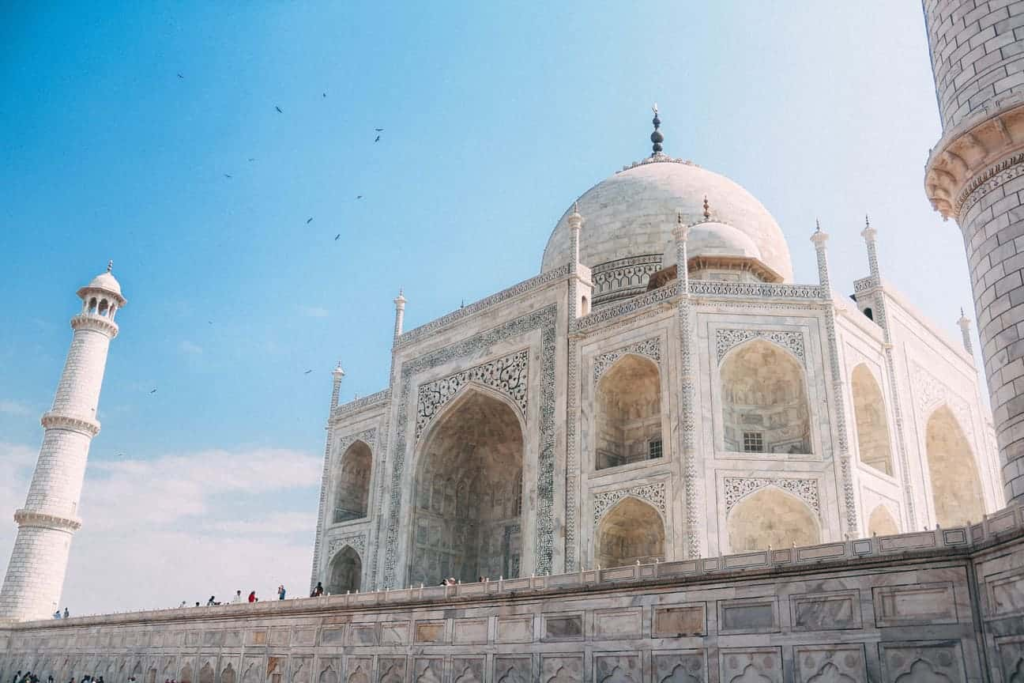The Taj Mahal is a timeless symbol of love and an architectural marvel, located in Agra, India. Its story is one of romance, loss, and enduring legacy, intricately woven into the history of the Mughal Empire.
The Love Story

The tale begins with Emperor Shah Jahan, the fifth Mughal ruler, and his beloved wife, Mumtaz Mahal. Born as Arjumand Banu Begum, Mumtaz Mahal was Shah Jahan’s third wife and his favorite. Their love was profound, and Mumtaz Mahal was not only his companion but also his trusted advisor. They shared 19 years of marriage and had 14 children together.
Tragic Loss

In 1631, Mumtaz Mahal tragically died during childbirth, while giving birth to their 14th child. Devastated by her death, Shah Jahan decided to build a monument that would immortalize her beauty and their love. Thus, the idea of the Taj Mahal was conceived.
Construction

Construction of the Taj Mahal began in 1632 and continued for approximately 22 years, involving over 20,000 artisans and craftsmen from across the empire and beyond. The chief architect is believed to be Ustad Ahmad Lahauri, and the design incorporated Persian, Islamic, and Indian architectural elements.
Architectural Marvel

The Taj Mahal stands on a raised platform along the banks of the Yamuna River. The central structure is a large, white marble mausoleum topped with a massive dome, flanked by four minarets. The interior houses the cenotaphs of Mumtaz Mahal and Shah Jahan, with the actual graves lying in a lower chamber. The intricate inlay work, known as pietra dura, adorns the walls, with semi-precious stones forming elaborate floral designs.
Gardens and Surroundings

The mausoleum is part of a larger complex that includes a mosque, a guest house, and vast formal gardens arranged in the charbagh (four-part) style, symbolizing paradise. The reflecting pool and the meticulously maintained gardens enhance the symmetry and beauty of the entire site.
Legacy
Shah Jahan was later overthrown by his son, Aurangzeb, and spent his remaining years under house arrest in the Agra Fort. Legend has it that he spent his last days gazing at the Taj Mahal, the eternal symbol of his love for Mumtaz Mahal. Upon his death, Shah Jahan was buried beside his beloved wife in the Taj Mahal.
Significance
The Taj Mahal is not only a UNESCO World Heritage site but also one of the New Seven Wonders of the World. It attracts millions of visitors each year, drawn by its beauty and the poignant love story it represents.
Preservation
Efforts have been made to preserve this iconic monument from the ravages of time, pollution, and environmental changes. Restoration projects and strict regulations help ensure that the Taj Mahal continues to inspire awe and admiration for generations to come.
The story of the Taj Mahal is a testament to the enduring power of love and the remarkable heights it can achieve, leaving an indelible mark on history and culture.
Best Time to Visit

- October to March: The weather is cooler and more pleasant, ideal for sightseeing.
- Avoid: Summers (April to June) can be extremely hot, and the monsoon season (July to September) can be humid.
Getting There

- By Air: The nearest airport is Agra’s Kheria Airport, about 13 km from the Taj Mahal.
- By Train: Agra is well-connected by train. The nearest stations are Agra Cantt, Agra Fort, and Agra City.
- By Road: Agra is accessible via NH-2 from Delhi, about a 3-4 hour drive.
Visiting Hours and Tickets

- Open: Sunrise to sunset, closed on Fridays for prayer.
- Night Viewing: Available on full moon nights and two days before and after, except Fridays and during Ramadan.
- Tickets:
- Foreigners: INR 1100
- Citizens of SAARC and BIMSTEC countries: INR 540
- Indians: INR 50
- Additional charges for night viewing.
Key Attractions & Tips for Visitors

Key Attractions
- Main Mausoleum: Admire the stunning architecture and intricate marble inlay work.
- Charbagh Gardens: Symmetrical gardens divided into four parts, symbolizing paradise.
- Mosque and Jawab: Red sandstone buildings flanking the mausoleum.
- Mehtab Bagh: For a beautiful view of the Taj from across the Yamuna River.
Tips for Visitors
- Footwear: Wear comfortable shoes; you’ll need to remove them or wear shoe covers inside.
- Photography: Photography is allowed, but tripods are not.
- Guides: Hire a government-approved guide for a more informative experience.
- Security: Expect strict security checks; avoid carrying large bags or prohibited items.
Nearby Attractions

- Agra Fort: Another UNESCO site, a short drive from the Taj Mahal.
- Fatehpur Sikri: A historic city located about 40 km from Agra.
- Itimad-ud-Daulah: Often referred to as the “Baby Taj”.
Enjoy your visit to one of the most beautiful monuments in the world!




